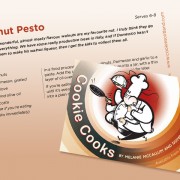Human Black Pudding with Pan-Fried Scallops and Apple
No one who knows me will be remotely surprised that I’ve chosen a recipe with black pudding in it. I love the stuff and have travelled across Europe in search of the perfect plate of pud. I’ve seen it being made in Scotland, Ireland, France and Austria, and eaten it in Belgium, Germany, Italy, Spain and Slovakia.
It’s made from blood for goodness sake! What self-respecting crime writer couldn’t love a dish made from blood? For this particular recipe, I’ve chosen to go with black pudding made from human blood. I know what you’re thinking… too much effort. But it’s actually much simpler than you’d think.
The dish is very much like the classic French boudin noir – but with a twist. The French version is made of one third blood, one third fat, and one third onions. My version is more tartan noir than boudin noir, hence the human blood. Not human fat though, that would be disgusting.
Execution
You will need three plastic buckets, each containing equal portions of blood, fat and chopped onions, plus a funnel, a length of intestine and a large pot. Mix the blood, fat and onions together (a word of warning: human blood thickens slightly faster than pig’s blood so make sure you keep stirring it or else it will congeal and you don’t want that), season to taste, then pour the mixture through the funnel into the intestine. It is entirely a matter of personal choice whether you use human or animal intestine but the latter is generally easier to get hold off and much less fiddly.
Keep the intestine moving as the blood mix enters it to avoid lumps or twists, coiling it as you go. Once it is full, tie off the end and drop the coil into a pan of hot – not boiling – water and simmer for about twenty minutes. Et voila! Le boudin tartan noir.
If you are too lazy to bother making it from human blood then my recommendation would be either the fine ready-made black puddings of either MacLeod & MacLeod of Stornoway or Ramsay’s of Carluke.
For the rest of the dish, simply melt a little butter or oil in a medium-sized frying pan and flash fry the scallops for about a minute on each side. Grill or fry the black pudding for a similar amount of time; ideally it will be crispy on the outside and moist inside so that you can still savour the tang of the blood.
To serve, slice up a green apple, or perhaps a pink lady, and arrange on the plate. Place a piece of black pudding on the apple, then a scallop on top of that.
Here’s a bonus tip! Get an apple corer and carefully remove a small circle at the heart of one of the black pudding rings. Do the same with a slice of apple and pop the apple circle into the centre of the black pudding. You now have a rich, delicious piece of black pudding with a crisp, sweet heart. Do not discard the cored piece of black pudding as that would be a mortal sin, pop it on top of a scallop instead.
Every dish needs an accompaniment but personally I couldn’t recommend any of those vegetable things that I hear people are eating these days. Instead I would advocate a liberal, yet not excessive, pouring of HP Guinness Sauce. If you feel the need to drink, I’d suggest a glass of Shiraz or a pint of double chocolate stout would go with it nicely. Bon appétit!

Buy The Killer Cookbook (ed. Caro Ramsay) here.











